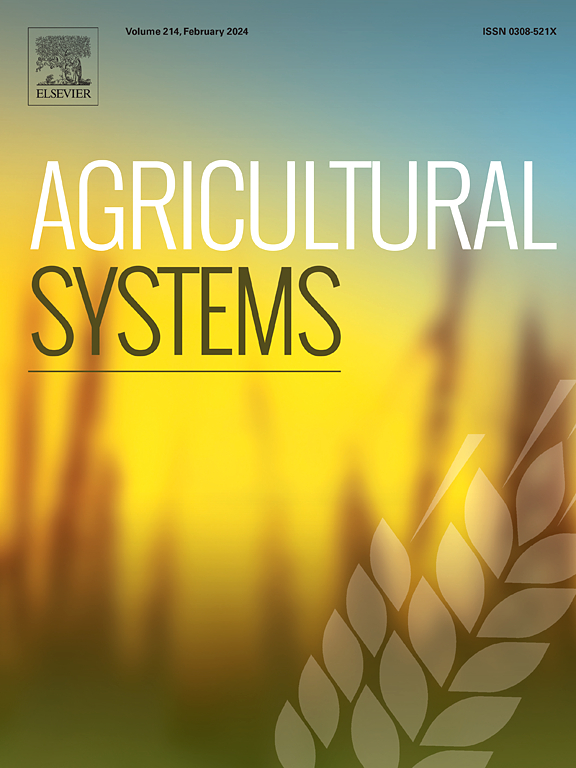Enhancing simulations of biomass and nitrous oxide emissions in vineyard, orchard, and vegetable cropping systems
IF 6.1
1区 农林科学
Q1 AGRICULTURE, MULTIDISCIPLINARY
引用次数: 0
Abstract
CONTEXT
Nitrous oxide (N2O) is a potent greenhouse gas with a high global warming potential. Specialty crop (SC) systems, including vineyards, orchards, and vegetable farms, are among the highest value crops grown and emit N2O. Knowledge regarding N2O emissions from SCs remains limited, necessitating simulations using process-based models. However, model calibration and validation for SC biomass dynamics and N2O emissions are lacking.
OBJECTIVE
This study aimed to: 1) conduct calibrations and validations of DayCent®, a process-based model, for SC biomass dynamics in eight SC systems with diverse pedological and climatic conditions; 2) evaluate N2O emission simulations based only on calibrating crop-specific parameters; and 3) simulate N2O emissions of each SC production region in California as a case study.
METHODS
A comprehensive dataset of 408 biomass carbon (C) and nitrogen (N) and 185 N2O emission observations from global field studies in eight SC systems was compiled. The DayCent model was calibrated and validated for SC biomass dynamics and N2O emissions across various management treatments, soils, and climates. Current yield-scaled N2O emissions were simulated for each SC among major production regions in California.
RESULTS AND CONCLUSIONS
Calibration on crop-specific parameters of DayCent based on the biomass collection can generally improve model performance for simulating biomass C (MRE = 0.148, RRMSE = 0.368, R2 = 0.913, IA = 0.976), N (MRE = 0.549, RRMSE = 0.711, R2 = 0.298, IA = 0.730), and N2O emissions (MRE = 1.226, RRMSE = 0.971, R2 = 0.407, IA = 0.772), compared with using original crop-specific parameterization for biomass C (MRE = 0.309, RRMSE = 0.847, R2 = 0.589, IA = 0.865), N (MRE = 1.327, RRMSE = 0.996, R2 = 0.001, IA = 0.366), and N2O emissions (MRE = 1.454, RRMSE = 1.102, R2 = 0.326, IA = 0.728), which also outperformed the 2019 refined IPCC Tier 1 method (MRE = 4.085, RRMSE = 1.835, R2 = 0.031, IA = 0.448). Yield-scaled annual N2O emissions averaged over the major production areas in California were 0.45, 0.18, 0.28, 0.46 kg N2O_N MgC−1 yr−1 for vineyards, almond, peach, and walnut orchards, and 1.02, 1.41, 1.18, and 1.37 kg N2O_N MgC−1 yr−1 for lettuce, broccoli, cauliflower, and tomato cropping systems, respectively. The case study identified high-emission regions and highlighted the spatial and temporal N2O emission variations at the county level.
SIGNIFICANCE
This is one of the very few comprehensive studies that compiled the largest dataset of biomass and N2O emissions from SC systems, as well as calibrated and validated model applications across diverse species, management practices, soil and climatic types. The findings underscored the need for process-based assessment of N2O emissions and targeted adoption of mitigation practices in high-emission areas to reduce emissions.

加强对葡萄园、果园和蔬菜种植系统中生物质和一氧化二氮排放的模拟
背景一氧化二氮(N2O)是一种强效温室气体,具有很高的全球变暖潜能。包括葡萄园、果园和蔬菜农场在内的特种作物(SC)系统是种植价值最高的作物之一,也会排放一氧化二氮。有关 SC 排放 N2O 的知识仍然有限,因此需要使用基于过程的模型进行模拟。然而,目前还缺乏针对 SC 生物量动态和 N2O 排放的模型校准和验证:本研究旨在:1)对 DayCent®(一种基于过程的模型)进行校准和验证,该模型适用于具有不同土壤和气候条件的八个 SC 系统中的 SC 生物量动态;2)评估仅基于作物特定参数校准的 N2O 排放模拟;以及 3)以加利福尼亚州的每个 SC 生产区为例,模拟其 N2O 排放。对 DayCent 模型进行了校准,并验证了不同管理处理、土壤和气候条件下的 SC 生物量动态和一氧化二氮排放量。结果和结论基于生物量收集对 DayCent 的作物特定参数进行校准,可普遍提高模型模拟生物量 C 的性能(MRE = 0.148, RRMSE = 0.368, R2 = 0.913, IA = 0.976), N (MRE = 0.549, RRMSE = 0.711, R2 = 0.298, IA = 0.730), and N2O emissions (MRE = 1.226,RRMSE = 0.971,R2 = 0.407,IA = 0.772),相比之下,对生物量 C(MRE = 0.309,RRMSE = 0.847,R2 = 0.589,IA = 0.865)、N(MRE = 1.327,RRMSE = 0.996,R2 = 0.001, IA = 0.366)和 N2O 排放量(MRE = 1.454, RRMSE = 1.102, R2 = 0.326, IA = 0.728),也优于 2019 年改进的 IPCC 第 1 级方法(MRE = 4.085, RRMSE = 1.835, R2 = 0.031, IA = 0.448)。加利福尼亚主要产区的产量标度年 N2O 排放量平均值分别为:葡萄园、杏仁园、桃园和核桃园为 0.45、0.18、0.28 和 0.46 千克 N2O_N MgC-1 yr-1,莴苣、西兰花、花椰菜和番茄种植系统为 1.02、1.41、1.18 和 1.37 千克 N2O_N MgC-1 yr-1。该案例研究确定了高排放区域,并强调了县级 N2O 排放的时空变化。意义这是为数不多的全面研究之一,它汇编了 SC 系统生物量和 N2O 排放的最大数据集,并校准和验证了不同物种、管理方法、土壤和气候类型的模型应用。研究结果表明,有必要对一氧化二氮排放进行基于过程的评估,并在高排放地区有针对性地采用减排措施,以减少排放。
本文章由计算机程序翻译,如有差异,请以英文原文为准。
求助全文
约1分钟内获得全文
求助全文
来源期刊

Agricultural Systems
农林科学-农业综合
CiteScore
13.30
自引率
7.60%
发文量
174
审稿时长
30 days
期刊介绍:
Agricultural Systems is an international journal that deals with interactions - among the components of agricultural systems, among hierarchical levels of agricultural systems, between agricultural and other land use systems, and between agricultural systems and their natural, social and economic environments.
The scope includes the development and application of systems analysis methodologies in the following areas:
Systems approaches in the sustainable intensification of agriculture; pathways for sustainable intensification; crop-livestock integration; farm-level resource allocation; quantification of benefits and trade-offs at farm to landscape levels; integrative, participatory and dynamic modelling approaches for qualitative and quantitative assessments of agricultural systems and decision making;
The interactions between agricultural and non-agricultural landscapes; the multiple services of agricultural systems; food security and the environment;
Global change and adaptation science; transformational adaptations as driven by changes in climate, policy, values and attitudes influencing the design of farming systems;
Development and application of farming systems design tools and methods for impact, scenario and case study analysis; managing the complexities of dynamic agricultural systems; innovation systems and multi stakeholder arrangements that support or promote change and (or) inform policy decisions.
 求助内容:
求助内容: 应助结果提醒方式:
应助结果提醒方式:


